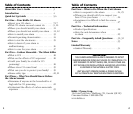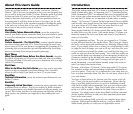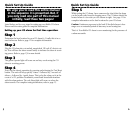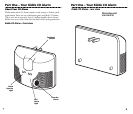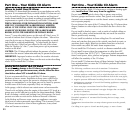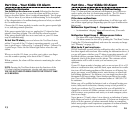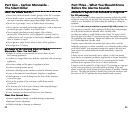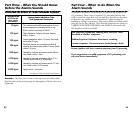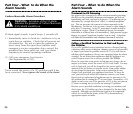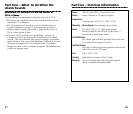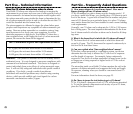
10
Part One – Your Kidde CO AlarmPart One – Your Kidde CO Alarm
Kidde’s Unique Features
Test/Reset Button
This button has two functions. First, this is the button you press
when you test the unit weekly (see page 15 for further details).
Secondly, you press this button if the unit alarms and you want to
turn it off. This will reset the unit and it will then again start monitor-
ing for CO. (If CO concentration is above 70 ppm, the alarm
will again sound within 6 minutes.)
Vents
Air (and CO) enters into the alarm at the bottom vent and circulates
through the sensing chamber. For proper air circulation, keep vents
free of dust, dirt or grease, (see “How to care for your CO alarm”
page 17). Do not obstruct or block vents, (see “Where to install
your CO alarm” on page 11).
Sensor
The sensor is a highly sensitive, electrochemical sensor that is CO-
specific to help avoid false alarms. Turn to page 17 for more infor-
mation on how to care for and protect the CO alarm.
Sounder Alarm
This is the loud 85 decibel pulsing alarm that will sound to alert you
to a potential problem. Alarm condition is 4 quick beeps – followed
by 5 seconds of silence – followed by 4 quick beeps, repeat.
Caution: Continuous exposure to this sound level at close range
over an extended period of time may cause hearing loss. We
recommend you cover the sounder with your finger while testing.
More on testing on page 15.
What Carbon Monoxide Alarms Can and Cannot Do
CO alarms are designed to sense unacceptable levels of CO from
malfunctioning furnaces, appliances, gas engines or other sources.
CO alarms provide early warning of the presence of carbon monox-
ide, usually before a healthy adult would experience symptoms.
This early warning is possible, however, only if your Kidde CO
alarm is located, installed and maintained as described in this user’s
guide.
This CO alarm is designed to act as a continuous monitor, it is not
designed for use as a short-term testing device to perform a quick
check for the presence of CO.
CO alarms have limitations. Like any other electronic device, CO
alarms are not fool-proof.
CO alarms have a limited operational life. You must test your CO
alarm weekly, because it could fail to operate at any time. If your
CO alarm fails to test properly, or if its self-diagnostic test reveals a
malfunction, immediately have the alarm replaced. See page 34 for
warranty information.
CO alarms will not work without power. This CO alarm requires a
continuous supply of electric power.
CO alarms can only sense CO that reaches the CO alarm’s
sensor. Carbon monoxide may be present in other areas without
reaching the alarm. The rate at which CO reaches the alarm may be
affected by doors or other obstructions. In addition, fresh air from a
vent or open window or any other source may prevent CO from
reaching the sensor. Please observe cautions on page
11, “Where to install your CO alarm.”
CO could be present on one level of the home and not reach a CO
alarm installed on a different level. For example, CO in
the basement may not reach a alarm on the second level, near the
bedrooms. For this reason, we recommend you provide complete
coverage by placing a CO alarm on every level of
the home.
CO alarms are not smoke alarms. CO alarms do not sense smoke or
fire. For early warning of fire you must install smoke alarms, even
though carbon monoxide can be generated by a fire.
CO alarms should not be used to detect the presence of natural gas
(methane), propane, butane, or other combustible fuels.
CO alarms are not a substitute for property, disability, life or other
insurance of any kind. Appropriate insurance coverage is your
responsibility. Consult your insurance agent.
9




